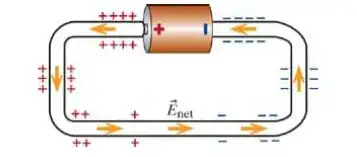
- How does the voltage/electric field of the battery relate to the surface charges on the wire?
- What determines the amount of surface charge on the wire? (Why more near the battery, less farther away)
- What are the surface charge doing?

You may find this document helpful, since it seems to be the primary source for the popularization of this idea. The short version is that the battery creates an electric field which pushes on the electrons in the wire. The field looks vaguely like this:

According to the above source, calculating surface charge distribution is extremely difficult. But if you look at the direction of the field lines and imagine your wire imposed on top of it, you can see that the electric field is going to be pulling electrons away from the left side and pushing them towards the right side. The surface charges eventually distribute themselves so as to create a uniform electric field throughout the wire:
Ultimately, this elegant negative feedback mechanism will produce an arbitrarily complex distribution of surface charge all over the wire such that the electric field due to all the charges (surface charge plus the charge on the [voltage source]) is uniform throughout the wire and has the magnitude predicted by conservation of energy (the Kirchhoff loop rule).
In conventional terminology "surface charge" describes the voltage (potential difference) between the opposing sides of a bi-state boundary (ex. liquid-gas, liquid-solid, etc). In your example you have only solids and therefore no "surface charge" by that convention.
By the most trivial interpretation, surface charges are everywhere in the metal wire and since the battery is the only electric field generator in the scenario, the field is constant and therefore the mobile charges on the surface of the wire are uniform (ideal, infinite wire). They don't cluster near the battery, nor reduce further from it.
In practical (and practical scale systems) you can perturb the distribution of charges in the wires, but it's irrelevant unless you are considering near-field effects. Since perturbations will cancel in the far-field to create the constant electric field required by the static sole-source configuration.
You may be misinterpreting the question asked of you, as it may refer to the surface charge induced on another object placed near the wire loop rather than on the wire in the picture itself.
This is because a concentration of charge causes an increase in the electric potential energy (with sign equal to the sign of the charge, or opposite, depending on your convention) in those charges (lots of repulsion). A low density causes low repulsion and low potential energy.
Ultimately, you can consider voltage and charge density as roughly equivalent concepts, one is the direct consequence of the other.
On the other side of the resistor, there is a charge defect (since charge is conserved). In other words, an accumulation of the opposite charge.
In your case, there is no resistor, so the whole wire will act a a resistor. The effect I described then occurs in every point in the wire. Charges accumulate at the end of the battery, and de-accumulate towards the other extreme, as they get slower and slower because of the friction of the wire.
In summary; The electric field from the battery pushed the charges, push the charges next to them, etc. Then the friction of the wire slows them down, causing accumulation of charges, which in turn causes more electric fields to push the charges. Eventually, a steady state is reached.